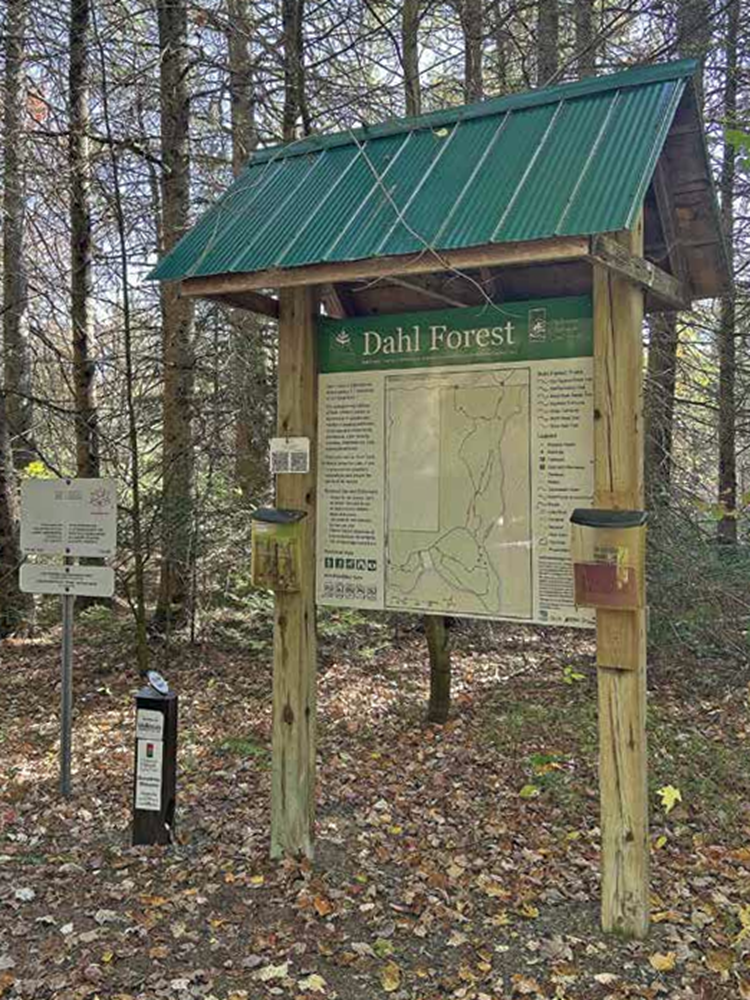It’s been more than six months of “painstaking” work for about 20 Countybased volunteers, but the Haliburton Highlands Land Trust (HHLT) has reopened its seven trails around Dahl Forest nature reserve.
The 500-acre site was closed to the public following the March ice storm, with HHLT’s Joan Duhaime saying hundreds of felled trees had to be cleared from the roughly five-kilometre trails system, while several “danger trees” – still standing, but at-risk of falling – also had to be cut down.
Duhaime said that’s brought on a new-look for the reserve, which reopened Oct. 9.
“The red pine plantation was very badly impacted – there were literally hundreds of trees down,” Duhaime said. “We’re leaving the limbs where they are. The forest will regenerate, which is a good thing. This all seems really bad…but this is a very natural thing. We think this might increase the diversity of the forest.
“It didn’t happen in a way that we would have chosen, but we can already see new growth in there because there’s so much more light coming in now,” Duhaime said.
The Land Trust raised $16,000 for cleanup, with about half of that spent so far. Duhaime said HHLT hired Geeza Road Mini Excavation Co. to help clear trails.
“It took them four full days with a tractor and grappler to get through everything,” Duhaime said, with limbs pushed back into the forest. She said Outram Tree Services were drafted in to deal with the danger trees – with one more felled last week.
The big stumbling block to reopening was dealing with downed hydro lines, which connected to a house Peter and Jan Dahl were using at the time of the storm. Duhaime said HHLT opted to remove the poles and wires and leave the property without a hydro connection.
Because the Dahls donated the land to HHLT, in 2009 via the federal government’s ecological gifts program, Duhaime said the Land Trust has to get approval before it makes any changes to land use.
“We’ll be talking to see what we can do with the house, if we can still use it,” Duhaime said.
The Dahls, who lived at the house for part of the year, have opted to relocate permanently to British Columbia.
Duhaime said the aftermath of the ice storm has been the most significant event the Land Trust has ever had to deal with – saying volunteers assisted with fundraising, contractor visits, project estimates and budgets, and dealing with insurance.
Work will continue, she said – there’s leftover funds to deal with any problematic trees, while a partnership with U-Links could be right around the corner.
“We’ve put in a proposal to have someone study the regeneration process of the plantation. It’ll be quite interesting noting the impacts,” Duhaime said. “I live across from Geeza Road and there was a red pine plantation beside our driveway. We’re now seeing a lot of different trees we didn’t even know were in there.”
She said public response to the reopening has been strong, with many taking to the trails over the past couple of weeks.
“We know people are keen to get out there and hike on the trails again, but we are warning folks to be cautious,” she said. “It’s not like there’s anything in there that will be toppling frequently, but the forest took a battering. As snow starts to fall, or we have a windy day, new things arise. So, we’re keeping our eye on some areas and how things develop.”
Duhaime confirmed ‘Discovery Days’ will be back in 2026, with HHLT receiving another grant from the TD Friends of the Environment Fund to run the initiative. “We’re planning a great schedule of events for next year”





